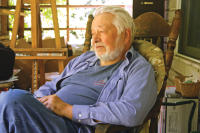Life in Hazel Creek: Mountain Discovery Charter School 8th-graders experience life as pre-national park settlers
Editor’s note: The following is series of student-written excerpts from a five-day camping trip taken to the Hazel Creek area of the Great Smoky Mountains National Park. The trip was taken by eighth-grade students from Mountain Discovery Charter School in Bryson City.
Day One:
The eighth-grade class loaded a Nantahala Outdoor Center bus with Southwestern Community College canoes and paddles. Director of Outdoor Education, Carter Petty said, “The trip would not have been possible without the contributions from Nantahala Outdoor Center and Southwestern Community College.”
The group then drove to Cable Cove and launched the canoes. Before the students set off on their journey, teachers asked them to compare their trip to Hazel Creek to the early settlers’ experience. From there it was the beginning of a week-long fun, and educational adventure. The canoe trip was two miles. After that, the students hiked four miles with heavy school back packs to their campsites.
Mountain Discovery’s well structured P.E. program prepared the eighth-grade class for the strenuous exercise during the trip. After hiking, the eighth-grade class set up camp and began cooking dinner. Eighth-grade student Sidney Parham thoughtfully informed the teachers, “It was a once in a lifetime opportunity to learn life skills while also learning to work with other people.” Writing by headlamps, the students journaled about their day as early settlers. Students finished the day telling ghost stories around their camp fire.
Day Two
On Tuesday, the eighth-grade class woke up to the sounds of Hazel Creek. The students were all sore from their paddle across the lake and the 4-mile hike to the campsite on the previous day. Everyone ate bagels toasted in a frying pan with peanut butter or cream cheese for breakfast. After finishing the meal, leftovers went into the food bags to hang on bear cables, so the bears wouldn’t raid the campsite.
Splitting into groups, everyone read specific pages in the book, Fontana: A Pocket History by Lance Holland, about different subjects, including mining, logging, splash dams, and Horace Kephart’s contributions to the establishment of the Great Smoky Mountains National Park. After the class discussed these topics as a group, they packed up daypacks and went for a 5-mile hike to the Adams-Westfeldt mine. The class took their time and took a few breaks on the way there. Finally, the group discovered the spot on the trail that led to the mine and hiked through briars to get there.
Bushwhacking through the thick undergrowth led the group to a very steep part of the mountainside. Students climbed next to a 30-foot deep mine pit, which anyone could have easily fallen into if it hadn’t been fenced off. When finally reaching the highest point of the mine opening, the class paired up and went in. What was inside was amazing. Students witnessed gleaming ore streaking through the shaft. It was dark and cold with puddles of water everywhere. There was even a bat hanging from the ceiling! After everyone had climbed through the cave, they hiked back to the campsite along Hazel Creek for writing and dinner.
As students busily recorded the day’s events in their journals, their teacher, Mr. Killebrew, cut wood for a campfire. As the sun began to set, all sat around the campfire, listened to each other’s ghost stories, and relaxed. When it was time for “lights out,” everyone got into sleeping bags for a well-earned rest.
Day Three:
After waking up to a nice early morning drizzle, the students enjoyed a nice breakfast of fried bagels and g.o.r.p. (good ol’ raisins and peanuts), the students proceeded with their plans to hike to another campsite, which was about 3 miles away from the one they had been staying in so far.
After the hike, the students set up their tarps, did some reading, and then four of the students — Ethan Swartzentruber, Cassidy Quillen, Sidney Parham, and Colyn Petty — went to help one of their other teachers (who was swapping out for Mr. Jim Killebrew, who had been with them so far) get her things and herself up to the campsite. The students hiked down to the place where they had left their canoes on Monday, got into a canoe, and went out to get the other teacher, Mrs. Randa Jobe, who was quickly and efficiently brought to shore.
After a short hike back to camp with Mrs. Jobe, the students began to cook supper. After a wholesome meal of burritos filled with rice, refried beans, cheese, and salsa, the students enjoyed a quick reading of “The Lorax” by Dr. Suess, and went to sleep.
Day Four:
After the light drizzle the previous day, the eighth-grade students set out towards the Proctor graveyard to learn of Hazel Creek’s ancestry. They made their way up through beautiful scenery towards the graveyard. As the students arrived, the cemetery surroundings reminded them of a great and luscious garden where the departed should be laid to rest.
The group learned of the town’s august lineage starting with Moses and Patience Proctor, the founders of the town of Proctor. The gravestones taught students about life spans in Proctor. While at the cemetery, students also learned about the controversy over the North Shore Road. The eighth-graders learned about the reasons behind both opinions on the Road to Nowhere. Students were amazed that any elderly person would ever be able to access such a remote spot without modern transportation in order to visit their departed loved one’s gravesites.
Later, after doing a tree study around the campsite, most of the eighth-graders went for a swim in a nearby swimming hole. The water was unbelievably cold. One at a time, the students would enter the water, and eventually, being persuaded by their peers, go underwater. At one point, all the eighth-raders ran into the frigid creek and fell forward into the water. The students enjoyed swimming, and the temperature of the water in some ways increased and in other ways stifled the fun in this experience. Most of the time was spent shivering on the waterside, joking and watching Ethan Swartzentruber spiking up his wet hair, a talent the class has been entertained by on many occasions.
Soon, the eighth-graders were tired of their goose bumps and chattering teeth and proceeded to change clothes and make dinner; dinner was rather unappetizing that night. There was a group discussion after the dishes and stoves were cleaned and put away, and after that, they went to bed.
There was a slight issue that had to be dealt with before turning in for the night. There were some men in a campsite that the groups feared were drinking alcohol, which was worrisome for the girls camping nearby. Within minutes, the classmates worked together to relocate the girls closer to the main group where they felt much safer. This showed how much could be done when classmates workd together with a common goal. Thus ended Day 4 of the Hazel Creek camping trip for the Mountain Discovery School eighth-graders.
Day Five:
After a long night on Thursday, the whole class woke up and started to cook toasted bagels and oatmeal. When the group got done cleaning the campsite up, it was time to get into the boats and head back. When canoeing back to the bus, most of the class saw river otters swimming around in the water. The students who saw the otters were amazed how close the otters were to the boats.
Upon arrival, the exhausted students took everything out of the boat and loaded the bus. Several students helped load the boats onto the bus, while others were cleaning out the boats and securing the life vests and paddles. Finally, the group of eighth-graders jumped on the bus to head to Fontana dam.
Upon arrival at the dam, students learned about how long it took to build the dam and how many people it took to build the dam. Students explored the structure of the dam as Mr. Carter Petty explained the building process.
Time to leave the dam ... students were very happy because everyone had missed the little things like running water, bathrooms, and their own beds. Students had gotten used to the challenges that were put in front of them, and they all worked together to make the trip exciting. Since their return, students have been working together like one big family. This camping trip was a great way to get everyone to open students’ eyes about the hardships endured by early settlers and how one company such as the Ritter Lumber Company can impact so many lives in both positive and ultimately negative ways through taker methods of clear cutting timber, then leaving the land scarred and people without jobs when resources get depleted.
We must all learn from the example set by the Ritter Lumber Co. and consider all consequences on people and ecosystems when we continue to take and consume without regard for our surroundings and others. We CAN make a difference with a greater awareness of the world around us and our impact on it.





